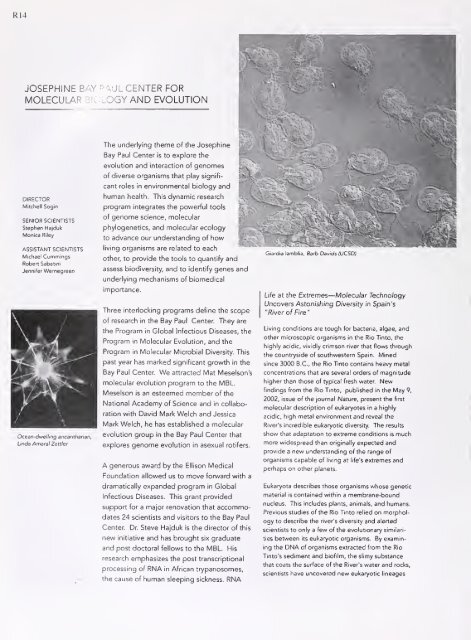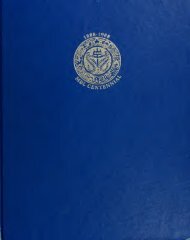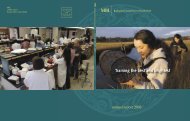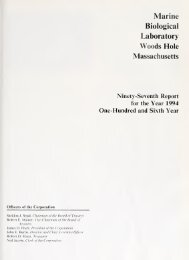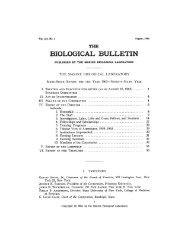View/Open - HPS Repository - Arizona State University
View/Open - HPS Repository - Arizona State University
View/Open - HPS Repository - Arizona State University
Create successful ePaper yourself
Turn your PDF publications into a flip-book with our unique Google optimized e-Paper software.
R14<br />
JOSEPHINE BAY F<br />
MOLECULAR E<br />
CENTER FOR<br />
OGY AND EVOLUTION<br />
DIRECTOR<br />
Mitchell Sogin<br />
SENIOR SCIENTISTS<br />
Stephen Hajduk<br />
Monica Riley<br />
ASSISTANT SCIENTISTS<br />
Michael Cuirtmings<br />
Robert Sabatmi<br />
Jennifer Wernegreen<br />
Ocean-dwelling ancantnanan,<br />
Linda Amaral Zettler<br />
The underlying theme of the Josephine<br />
Bay Paul Center is to explore the<br />
evolution and interaction of genomes<br />
of diverse organisms that play significant<br />
roles in environmental biology and<br />
human health.<br />
This dynamic research<br />
program integrates the powerful tools<br />
of genome science, molecular<br />
phylogenetics, and molecular ecology<br />
to advance our understanding of how<br />
living organisms are related to each<br />
other, to provide the tools to quantify and<br />
assess biodiversity, and to identify genes and<br />
underlying mechanisms of biomedical<br />
importance.<br />
Three interlocking programs define the scope<br />
of research in the Bay Paul Center. They are<br />
the Program in<br />
Program in<br />
Global Infectious Diseases, the<br />
Molecular Evolution, and the<br />
Program in Molecular Microbial Diversity. This<br />
past year has marked significant growth in the<br />
Bay Paul Center. We attracted Mat Meselson's<br />
molecular evolution program to the MBL.<br />
Meselson is an esteemed member of the<br />
National Academy of Science and in collaboration<br />
with David Mark Welch and Jessica<br />
Mark Welch, he has established a molecular<br />
evolution group in the Bay Paul Center that<br />
explores genome evolution in asexual rotifers.<br />
A generous award by the Ellison Medical<br />
Foundation allowed us to move forward with a<br />
dramatically expanded<br />
in<br />
program Global<br />
Infectious Diseases. This grant provided<br />
support for a major renovation that accommodates<br />
24 scientists and visitors to the Bay Paul<br />
Center.<br />
Dr. Steve Hajduk<br />
is the director of this<br />
new initiative and has brought six graduate<br />
and post doctoral fellows to the MBL. His<br />
research emphasizes the post transcriptional<br />
processing of RNA in African trypanosomes,<br />
the cause of human sleeping sickness. RNA<br />
Giardia lamblia. Barb Davids (UCSD)<br />
Life at the Extremes<br />
Molecular Technology<br />
Uncovers Astonishing Diversity in Spain's<br />
"River of Fire"<br />
Living conditions are tough for bacteria, algae, and<br />
other microscopic organisms<br />
in the Rio Tinto, the<br />
highly acidic, vividly crimson river that flows through<br />
the countryside of southwestern Spain. Mined<br />
since 3000 B.C., the Rio Tinto contains heavy metal<br />
concentrations that are several orders of magnitude<br />
higher than those of typical fresh water. New<br />
findings from the Rio Tinto, published in the May 9,<br />
2002, issue of the journal Nature, present the first<br />
molecular description of eukaryotes in a highly<br />
acidic, high metal environment and reveal the<br />
River's incredible eukaryotic diversity. The results<br />
show that adaptation to extreme conditions is much<br />
more widespread than originally expected and<br />
provide a new understanding of the range of<br />
organisms capable of living at life's extremes and<br />
perhaps on other planets.<br />
Eukaryota describes those organisms whose genetic<br />
material is contained within a membrane-bound<br />
nucleus.<br />
This includes plants, animals, and humans.<br />
Previous studies of the Rio Tinto relied on morphology<br />
to describe the river's diversity and alerted<br />
scientists to only a few of the evolutionary similarities<br />
between its eukaryotic organisms.<br />
By examining<br />
the DNA of organisms extracted from the Rio<br />
Tmto's sediment and biofilm, the slimy substance<br />
that coats the surface of the River's water and rocks,<br />
scientists have uncovered new eukaryotic lineages


